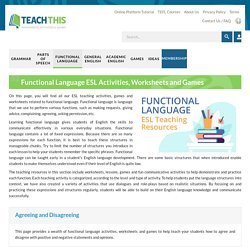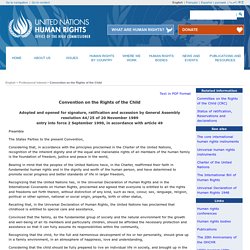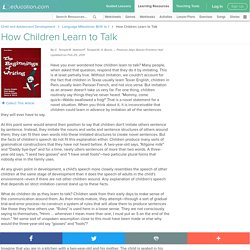

English Teacher,EFL Santiago,Chile
Functional Language ESL EFL Activities Worksheets Games. Learning functional language gives students of English the skills to communicate effectively in various everyday situations.

Functional language contains a lot of fixed expressions. Because there are so many expressions for each function, it is best to teach these structures in manageable chunks. Try to limit the number of structures you introduce in each lesson to help your students remember the specific phrases. Functional language can be taught early in a student’s English language development. There are some basic structures that when introduced enable students to make themselves understood even if their level of English is quite low. The teaching resources in this section include worksheets, lessons, games and fun communicative activities to help demonstrate and practice each function. This page provides a wealth of functional language activities, worksheets and games to help teach your students how to agree and disagree with positive and negative statements and opinions. The language learning theories of Professor J. Cummins. The information and advice on this page was written for FIS teachers in advance of the visit to the school of Professor J.

Cummins. Cummins is one of the world’s leading authorities on bilingual education and second language acquisition. Mainstream teachers who have a knowledge of his theories and act on his advice will be in a much stronger position to help the ESL students in their classes. Cummins makes the distinction between two differing kinds of language proficiency. BICS are Basic Interpersonal Communication Skills; these are the "surface" skills of listening and speaking which are typically acquired quickly by many students; particularly by those from language backgrounds similar to English who spend a lot of their school time interacting with native speakers. CALP is Cognitive Academic Language Proficiency, and, as the name suggests, is the basis for a child’s ability to cope with the academic demands placed upon her in the various subjects. An error has occurred. TEFL jobs - Eslbase.com. Password protected padlet. Convention on the Rights of the Child.
Text in PDF Format Adopted and opened for signature, ratification and accession by General Assembly resolution 44/25 of 20 November 1989 entry into force 2 September 1990, in accordance with article 49 Preamble The States Parties to the present Convention, Considering that, in accordance with the principles proclaimed in the Charter of the United Nations, recognition of the inherent dignity and of the equal and inalienable rights of all members of the human family is the foundation of freedom, justice and peace in the world, Bearing in mind that the peoples of the United Nations have, in the Charter, reaffirmed their faith in fundamental human rights and in the dignity and worth of the human person, and have determined to promote social progress and better standards of life in larger freedom, Recalling that, in the Universal Declaration of Human Rights, the United Nations has proclaimed that childhood is entitled to special care and assistance, Have agreed as follows: Article 1 Article 2 1. 2.

Home - ECEC. How Children Learn to Talk. Have you ever wondered how children learn to talk?

Many people, when asked that question, respond that they do it by imitating. This is at least partially true. Without imitation, we couldn't account for the fact that children in Texas usually learn Texan English, children in Paris usually learn Parisian French, and not vice versa. But imitation as an answer doesn't take us very far. For one thing, children routinely say things they've never heard: "Mommy, come quick—Waldo swallowed a frog! " At this point some would amend their position to say that children don't imitate others sentence by sentence. At any given point in development, a child's speech more closely resembles the speech of other children at the same stage of development than it does the speech of adults in the child's environment—even if there are not other children around.
What do children do as they learn to talk? Imagine that you are in a kitchen with a two-year-old and his mother. Child: Want other one spoon, Daddy. Does being bilingual make you smarter? Language teacher and researcher Miguel Angel Muñoz explains the latest research on how being bilingual affects your brain, ahead of a British Council seminar in Cardiff on whether learning a foreign language makes you smarter. You can watch the live-streamed seminar on Tuesday, 3 June. More than half the world's population uses two or more languages every day It is hard to estimate the exact number of bilingual people in the world, as there is a lack of reliable statistics . But in 2012, a Eurobarometer survey established that 'just over half of Europeans (54%)' are bilingual, and other studies hypothesise that more than half of the world’s population is bilingual. So what about you? Being bilingual isn't black-and-white To answer that question, first we need to establish what being bilingual means.
I, for example, am -- or used to be -- proficient in German, but I have not used my German regularly for a very long time. How can young children best learn languages? The British Council's Tracey Chapelton explains how parents of young children can lay the foundations for success. Children's brains are highly active Your child is unique, but what all children have in common is natural curiosity and an innate ability to learn. TRACEY CHAPELTON: 'Phonics for Very Young Learners of EFL: A Creative Approach' Total Physical Response (TPR) Total Physical Response (TPR)